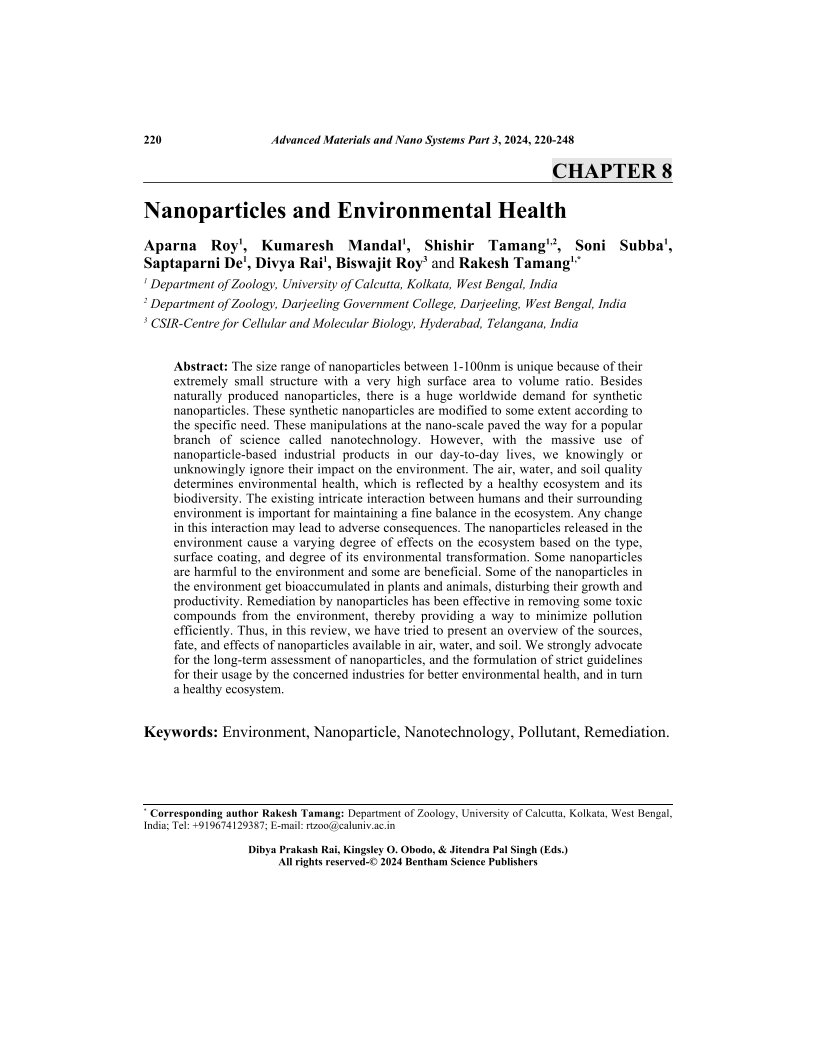Nanoparticles and Environmental Health

- Authors: Aparna Roy1, Kumaresh Mandal2, Shishir Tamang3, Soni Subba4, Saptaparni De5, Divya Rai6, Biswajit Roy7, Rakesh Tamang8
-
View Affiliations Hide Affiliations1 Department of Zoology, University of Calcutta, Kolkata, West Bengal, India 2 Department of Zoology, University of Calcutta, Kolkata, West Bengal, India 3 Department of Zoology, University of Calcutta, Kolkata, West Bengal, India 4 Department of Zoology, University of Calcutta, Kolkata, West Bengal, India 5 Department of Zoology, University of Calcutta, Kolkata, West Bengal, India 6 Department of Zoology, University of Calcutta, Kolkata, West Bengal, India 7 CSIR Centre for Cellular and Molecular Biology, Hyderabad, Telangana, India 8 Department of Zoology, University of Calcutta, Kolkata, West Bengal, India
- Source: Advanced Materials and Nano Systems: Theory and Experiment (Part 3) , pp 220-248
- Publication Date: July 2024
- Language: English
Nanoparticles and Environmental Health, Page 1 of 1
< Previous page | Next page > /docserver/preview/fulltext/9789815223101/chapter-8-1.gif
The size range of nanoparticles between 1-100nm is unique because of their extremely small structure with a very high surface area to volume ratio. Besides naturally produced nanoparticles, there is a huge worldwide demand for synthetic nanoparticles. These synthetic nanoparticles are modified to some extent according to the specific need. These manipulations at the nano-scale paved the way for a popular branch of science called nanotechnology. However, with the massive use of nanoparticle-based industrial products in our day-to-day lives, we knowingly or unknowingly ignore their impact on the environment. The air, water, and soil quality determines environmental health, which is reflected by a healthy ecosystem and its biodiversity. The existing intricate interaction between humans and their surrounding environment is important for maintaining a fine balance in the ecosystem. Any change in this interaction may lead to adverse consequences. The nanoparticles released in the environment cause a varying degree of effects on the ecosystem based on the type, surface coating, and degree of its environmental transformation. Some nanoparticles are harmful to the environment and some are beneficial. Some of the nanoparticles in the environment get bioaccumulated in plants and animals, disturbing their growth and productivity. Remediation by nanoparticles has been effective in removing some toxic compounds from the environment, thereby providing a way to minimize pollution efficiently. Thus, in this review, we have tried to present an overview of the sources, fate, and effects of nanoparticles available in air, water, and soil. We strongly advocate for the long-term assessment of nanoparticles, and the formulation of strict guidelines for their usage by the concerned industries for better environmental health, and in turn a healthy ecosystem.
-
From This Site
/content/books/9789815223101.chapter-8dcterms_subject,pub_keyword-contentType:Journal -contentType:Figure -contentType:Table -contentType:SupplementaryData105

